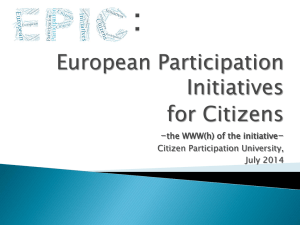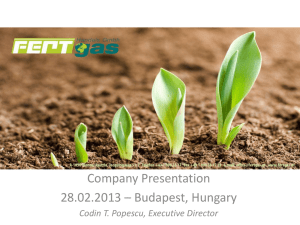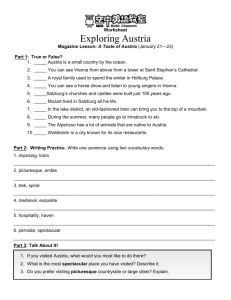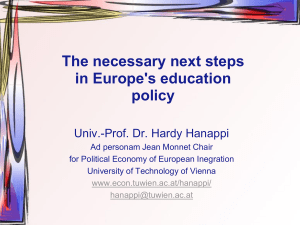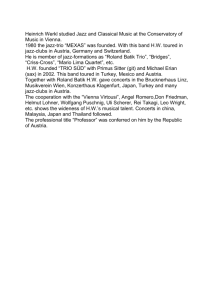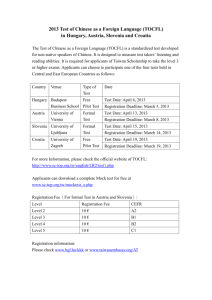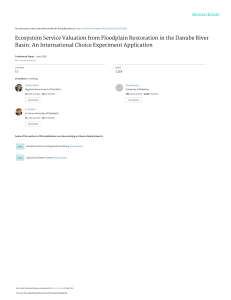Ecosystem Service Valuation from Floodplain International Choice Experiment Application
advertisement
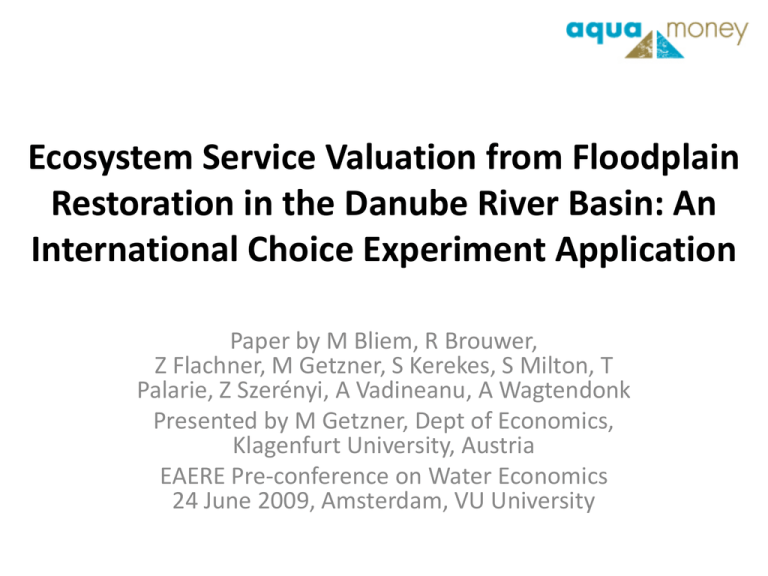
Ecosystem Service Valuation from Floodplain Restoration in the Danube River Basin: An International Choice Experiment Application Paper by M Bliem, R Brouwer, Z Flachner, M Getzner, S Kerekes, S Milton, T Palarie, Z Szerényi, A Vadineanu, A Wagtendonk Presented by M Getzner, Dept of Economics, Klagenfurt University, Austria EAERE Pre-conference on Water Economics 24 June 2009, Amsterdam, VU University Presentation outline • • • • • River restoration – measures and benefits Common valuation design Estimated choice models Welfare measures Best practice recommendations Danube river basin • Second largest river in Europe (2850 km) • Most river stretches classified as HMWB • Lack of river connectivity, canalization, regulation, hydropower • Ecological restoration important measure to reach GES • Costly, benefits unknown Main objectives • Economic valuation of the non-market benefits of ecological floodplain restoration - Flood control - Water quality improvement - (other potential benefits, such as biodiversity conservation/dynamics and natural processes, not included) • Transferability of benefits in international context: Austria, Hungary, Romania Location of river restoration projects Design of a choice experiment • • • • Description of river restoration Water supply and waste water treatment Experience with floods CE: Management alternatives and status quo • (CV) • Debriefing questions 10 Overview of attribute levels Attributes Flood frequency Water quality Increase in water bill Levels Once every 5 Once every 25 Once every 50 Once every 100 years years years years Moderate Good Very Good There is a limited There is a good natural The water is in a very variety of aquatic life range of fish and plant near-natural state. but far from natural. species. All Natural conditions are Boating is OK but recreational uses are optimal for a full water quality is still possible, but swimming range of aquatic life. too poor for may be a little bit risky All recreational uses swimming. Fishing is during certain time such as swimming and possible but not for periods. Consumption fishing are possible. consumption. of caught fish possible without much risk for human health. €3 € 10 € 30 € 50 Example choice card Option A Flood frequency Option B Status Quo Once every 25 Once every 25 Once every 5 years years years Good Very good Moderate €3 (25 Cent / month) € 10 (83 Cent / month) No additional payment Water quality Increase in water bill I choose: (Please tick as Option A appropriate) Option B Neither Implementation of the surveys • Austria: web-based survey 1977 respondents Nov 2007, response 26% (n=506) • Hungary: 892 face-to-face interviews Nov-Jan 2008, response 53% (n=471) • Romania: 850 face-to-face interviews Nov 2007, response 61% (n=519) Sample characteristics Distribution (%) Austria Hungary Romania Share male 48 55 51 15-19 year 10 6 3 20-29 18 20 16 30-39 21 19 22 40-49 22 17 21 50-59 18 20 21 >=60 11 18 17 €0-500/month 8 29 68 €501-1000 13 46 25 €1001-2000 38 23 6 €2001-3000 24 1 1 > €3000 17 1 0 Water quality perception Flood experience Austria Hungary Romania 16% 19% 8% RPL model results Implicit prices MWTP (€/household/yr) Austria Hungary Romania Δ flood frequency (year) 0.20 (0.05) 0 (n.s.) 0 (n.s.) Δ good water quality 44.5 (6.5) 21.2 (3.1) 23.0 (10.7) Δ very good water quality 75.3 (8.4) 42.5 (4.2) 36.8 (14.1) Policy scenarios (€/household/year) Policy scenario Flooding Austria Hungary Romania Water quality 1 Once every 25 yrs Good 69.6 (37.5-101.8) 20.2 (15.2-25.3) 4.8 (4.0-5.5) 2 Once every 50 yrs Good 73.5 (40.8-106.2) 20.2 (15.2-25.3) 4.8 (4.0-5.5) 3 Once every 25 yrs Very good 85.0 (50.2-119.8) 32.1 (26.3-37.9) 9.5 (6.8-12.2) 4 Once every 50 yrs Very good 88.8 (53.4-124.2) 32.1 (26.3-37.9) 9.5 (6.8-12.2) 5 Once every 100 yrs Very good 96.4 (59.6-133.3) 32.1 (26.3-37.9) 9.5 (6.8-12.2) 95% confidence intervals between brackets. Conclusions • Design of choice experiment – internationally comparable survey • Web-based survey • Aggregation – transferability of values – Distance-decay – Income differentials – Population – Generally different estimated models & scale parameters benefit transfer doesn’t work in our context Thank you very much for your attention! Steps 1) Conversion CS/household/year to per capita values 2) Conversion population density to number of inhabitants per 100x100m grid cell 3) CS/capita/year multiplied with number of inhabitants per 100x100m grid cell 4) Income factor multiplied with the change in income per grid cell (+/-) 5) Distance decay factor multiplied with the distance of each grid cell from the Danube river (-) 6) Summation income and distance adjusted TEV/grid cell across all grid cells Aggregation procedure • Spatial distribution population • Distance-decay • Income variation in space • CS/household/year >> TEV relevant market size Illustration of distance-decay effects for good water quality in Austria TEV for good and very good water quality on two aggregation procedures (€ 106/year) TEV1 unadjusted aggregation TEV2 GIS adjusted aggregation Distance-decay correction Distance-decay and income correction Austria Good water quality 54.0 46.3 41.9 Very good water quality 73.8 n.a. 69.4a good water quality 2.0 1.4 n.a. Very good water quality 3.9 3.3 n.a. Good water quality 10.2 5.0 4.4 Very good water quality 15.3 9.9 9.0 Hungary Romania a Income correction only. n.a: not available Illustration of TEV for very good water quality adjusted for distance-decay / income
